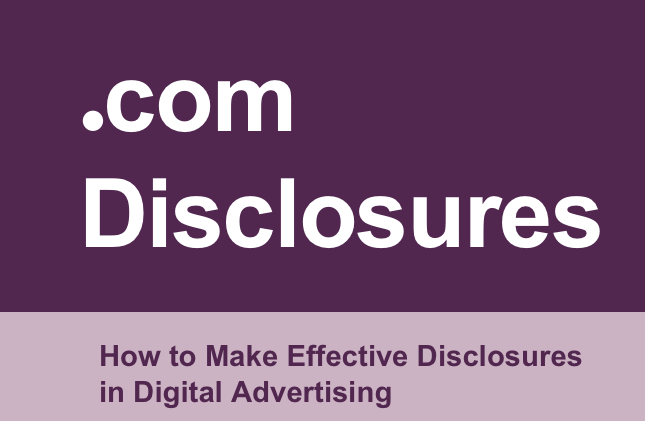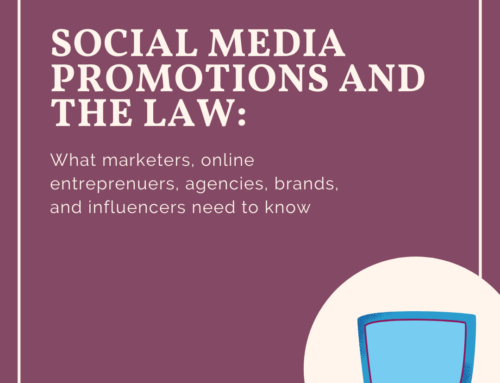
FTC Disclosure and Online Marketing
On March 12, 2013, the United States Federal Trade Commission (FTC) released the long-awaited Dot Com Disclosures. The FTC Dot Com Disclosures guide provides guidance for online and mobile advertisers. Last released in 2000, the internet back then looked very different than it does today. Even now, after over a year of working on this update, some of the information related to FTC Disclosure seems dated because technology is changing so quickly.
As soon as the guide was released I started getting emails and contacts asking questions and seeking clarification. The amount of inaccurate information I’ve seen in the few days after their release tells me that there is a need for helpful and accurate information for business, social media professionals and bloggers when it comes to the 2013 FTC’s Disclosures for Dot Com (and other domain endings) businesses.
1. These disclosures are NOT new laws. The 2013 Dot Com Disclosures, like its predecessor, is a guidance document. The FTC staff has made these documents public to assist businesses and professionals working in the online and mobile advertising space in creating their advertising programs so they comply with the FTC rules with regard to advertising and selling online and via mobile platforms. The guidelines only address disclosures required that relate to laws the FTC enforces.
2. The FTC Act continues to prohibit “unfair or deceptive acts or practices” with regard marketing, advertising, promotional and sales practices, in general. The FTC Act is platform neutral, with the goal of consumer protection being paramount. As new technologies and methods of engaging with consumers have come about, the requirement for appropriate disclosures has continued. This document seeks to clarify what is meant by “clear and conspicuous” disclosure to consumers.
3. The FTC’s basic principles of advertising law have not changed. Advertising must still be fair, truthful and not misleading, and have evidence to support all claims. The FTC is tasked with protecting consumers, and, as such, their evaluation of advertising uses the reasonable consumer as its standard.
4. These disclosures, both the content and their placement, aren’t measured by what the company or online marketer/professional thinks makes sense. If a disclosure is necessary or required so that an advertisement or marketing message does not violate an FTC rule or other law, then the disclosure should be clear and conspicuous. The guide provides a very good discussion of this topic. Mentioned are factors such as size of text, color, distracting factors, use of graphics, repetition, location, proximity to message, as well as the primary message of the advertisement.
5. Hyperlinks may be used for disclosures, but the FTC will look at a number of factors to determine if they meet the clear and conspicuous test. The FTC Disclosure guide provides a comprehensive discussion on this topic on pages 10 – 13. The general conclusion is that if you are going to use a hyperlinked disclosure you should read this section to fully understand how to do it within the parameters of compliance.
6. Understand the technical limitations of the platform. The FTC is very clear that pop-up disclosures are not to be used. Due to pop-up blockers, a user or consumer may not see the required disclosure creating a potential liability for the marketer. In addition, be aware of the issues related to the technology that may prevent the disclosure from being seen. Not all apps, browsers or mobile platforms function in the same way. What may work on one device may not work on all. In addition, common software may prevent hover disclosures or change link functionality. If these are known (or should be known) limitations, be prepared to create alternative means of disclosure.
7. For the first time, the FTC addresses disclosure on space-constrained platforms. For most, this means Twitter. The FTC states the disclosure should be at the beginning, using “AD” or “Sponsored” so the consumer is adequately informed. The FTC notes that using an abbreviation of the word “sponsored” is likely inadequate because the consumer will not know what the abbreviation means. While most advertisements or sales pitches are teasers and will lead the consumer to a site where it is much easier to provide full and appropriate disclosure, the space-constrained message may still need a disclosure.Furthermore, the FTC recognizes that space-constrained messages may be replicated (such as a retweet). With such replication, the advertiser needs to ensure there is sufficient space so the disclosure is maintained.

8. Since the FTC is primarily tasked with protecting consumers, it makes sense that the Dot Com Disclosures address the language used for the disclosure. Consumers have different levels of understanding. Online professionals may be very proficient at the utilized technology, but the consumer may not. How you use the technology may differ from how the consumer uses it, making it incumbent on the marketer and other online professions creating the message to craft a disclosure appropriate for the average consumer.
9. The Dot Com Disclosures do not change any of the requirements with regard to testimonials and endorsements used in advertising. When companies use third parties to share their message, through testimonials or endorsements, the FTC’s Endorsement Guides offer helpful information. The Dot Com Disclosures not only addresses additional situations with regard to marketing, sales and advertising in the mobile and online space, but it acts to clarify they types of disclosures that are required when the internet or mobile platforms are used. The disclosure requirement for bloggers, spokespeople, brand ambassadors, and other third-parties (like celebrities) remain the same.
While this update to the Dot Com Disclosures now incorporates technology that did not exit when the prior version was created, we don’t see many radical changes. These disclosures relate to online and mobile-technology communication with consumers that could lead to a buying decision. And while much of the focus is on the consumer protection aspect of these new Dot Com Disclosures, what is equally important is that compliance is also a tool which allows marketers and sellers to compete in a marketplace free of deception or unfair trade practices.
Who should use the Dot Com Disclosures? This guide should be used by brands, entrepreneurs, small businesses, PR companies, marketing strategists, online professionals, social media consultants and strategists as well as bloggers and others who use social media in conjunction with promoting a product or service to the consuming public. Non-compliance with this new update won’t bring a fine or a reprimand from the FTC. However, since these disclosures are a guide as to how the FTC will determine and evaluate unfair and deceptive trade practices which violate underlying laws it would not be wise to disregard them. The FTC is attempting to offer insight and transparency into what they look at in determining what consumer protection matters they will pursue. While it may not be exacting or crystal clear, it is an important tool to consider when making consumer focused marketing, advertising and sales decisions.
What are your thoughts about the 2013 FTC Dot Com Disclosures? Are you confused about what you have to do? Has the FTC gone too far? Are you mad because you disclose and others don’t?
Images courtesy of FTC Dot Com Disclosure Guide






The one that got me was the placement of the disclosure statement. What is your thoughts on this? In the example the FTC gave, they discouraged placing it at the end of the post if you use hyperlinks that could distract the consumer. Thanks for this great article. 🙂
Jennifer, the need for disclosure at the beginning/top of a post is still consisten with the Endorsement and Testimonial guide issued in 2010 that most bloggers already use. True, many do not put the disclosure at the beginning. However, the FTC does not require any specific legal language so by simply stating that you received an item free to try or “Brand X paid for me/my family to …” upfront is sufficient disclosure. The important thing to remember is that the potential consumer should know from the beginning that the post they are reading may not be completely objective. It’s not that you’re not being honest or truthful in your post, but rather by telling your reader what prompted you to write the reader can make their own decision.
Many bloggers do include hyperlinks (which should be “no follow” for SEO purposes) on paid/sponsored/compensated posts. Even if they are not affiliate links, it’s important for readers to know beforehand you’re providing that link because there is some relationship between you and the site you’re linking to.
Hope this helps. If you have other questions, please let me know.
~ Sara
Thank you for the useful information Sara! I shared your link with a large group I’m on because someone needed an attorney for a topic you covered. Anyway, can we put the disclosure in our side navigation so that people see it on every page or do we still have to put it at the top of our blog post? 🙂
The FTC has stated that a “blanket” disclosure is often not clear since sometimes it does not apply. Much would depend on the language of your disclosure and the nature of your website and posts. For some, everything they post is sponsored or paid so it would, perhaps, be pertinent to that situation. For others, it may not. Unfortunately, there is no one specific answer.
So by this example, a tweet needs to start with #ad #sponsored and we shouldn’t use the more common version of #spon any longer? Just want to understand what I’m reading.
Jennifer, the FTC has stated #spon may not sufficiently make consumers aware the message was an advertisement or compensated (not just with money) message.
Interestingly, if a consumer did go to next step to try and find out what exactly #spon meant they would come upon a website that claims to register hashtags and would be shown that it relates to one specific company.
Since people use #spon for so many different companies that would definitely be misleading or deceptive, which is likely one of the considerations taken when the FTC made the determination to explicitly state #spon could create confusion or be deceptive to consumers.
The further reasoning for adding the disclosure to the front of the message is to reduce the chance of it being removed if the message is further shared.
Thank you for reading and asking for further clarification. There was a lot of ground covered in the update.
~ Sara
Disclosure: for informational purposes only
As blogging continues to demand a more centralized place in marketing and social media, these disclosures and other governmental interferences are more important to understand. Thank you for taking the time to make it clear and plain. There are full committees studying how the government can get a lasso on these blogs and the revenue they may or may not generate.
I don’t see any changes here, except clarifying the need for readable disclosures on mobile devices, and making the AD: clear on the tweet vs. #spon or other things people might not see.
I am hearing chatter that every time I link to a blog post where I received a free product, I need to put AD: first on FB/Twitter. I’d say yes if I said something like “wow I’m using this new blue widget and it is totally amazing!!” But if I am just putting on Facebook: I posted a review of the blue widget the widget express sent me. Link to post here: http://www.widgetreviews.xyz
Then on my review I put the disclosure at the very top.
and btw the “recently posted” was not in any way sponsored, for the record. 🙂
[…] 2013 ftc dot com disclosure updates and what they mean for online marketers […]
[…] Sara Hawkins has written a wonderful breakdown of the FTC guidelines as part of her Blog Law series, and Blog With Integrity co-founder Susan […]
[…] FTC Disclosures & You ( a MUST read) and the update: 2013 FTC dot com disclosures. […]
[…] week before the conference, the FTC released new 2013 Dot Com Disclosures. Listen […]
[…] marketing, brand, social media, PR and digital professionals, what does the 2013 .com Disclosures guide mean for you? With regard to consumer protection laws themselves, not much. With regard to how […]
Hi
I am very thankful that I stumbled upon this site and I have noticed that you know a lot about ”blog law” which is really good because it seems that noone knows! I am an active internet user (more than 5hrs/day for years – I am a young adult so normal stuff) and yet as of a few months ago I didn’t know that people make money from blogging (well at least so many or so ”easily”). When, I came across this whole thing about making a supplemental income by blogging I was excited (about couple of months ago), then I read about this FTC ”thing” and it got me interested to know more because I want to think that I am a ”good” person and I am absolutely legal. Everything normal until now…
However, I want to disagree on an important aspect (it is not necessarily relevant to this article nor I disagree with anything you write, but more of a disagreement on what bloggers think about the disclosure).
Before I even read about the FTC regulations and anything to do with them and when I started reading various blogs and websites and understanding the terminology (like what an affiliate link means), I can honestly say that whenever anyone had on their website an affiliate link and it was stated, I would click on the link, look the product/service and then if I decided to purchase it, I would open a different tab and google the product/service and purchase it from a normal non-affiliated link. This was an instinctive response. In fact, I now recognise and distinguish affiliate links even if they are not disclosed and I do the very same thing. I talked with a friend and talked to him about blogging and what affiliate links are but I did not say what I was doing (that I actually avoided purchasing from affiliate links) to see if it was just an instinctive stupidity of mine or whether it can discourage anyone. Quite frankly he was being ironic when he saw disclosures about affiliate links and he would say something like – he is gone get money this is biased (and at the time I didn’t even mentioned what I have been doing). In my case though, I am pretty sure that the blogger is genuine and he is completely honest about his/her reviews about the product or service but it’s something that you can’t help it when you see something like ”I will get money if you buy this from my link”.
Do disclosures discourage a percentage of consumers from purchasing through affiliate links? Absolutely yes. Now, I do believe that bloggers who have established loyal readers are able to generate some revenue through them by building relationship and trust between the blogger and the reader, but I believe that many first time readers of authors and bloggers avoid affiliate links. In my opinion this is not something strange and should be expected that this would happen even though it is not logical. It is not a logical decision but an emotional. I never think that whenever I buy an amazon book I make Jeff Bezos richer, or that whenever I buy an iPad I make Apple richer or whenever I click on ads on websites I make Google richer. I never think of that because there is no reminder next to it to remind me that whenever I do so I will pay them (it is common sense this is what you are doing but you don’t think of it, unlike bloggers where you see ”I will get money if you buy that product even though its not mine”).
But, noone is above the law and everyone should follow the rules and this is another problem, because not all bloggers disclose with the same level of clarity (or disclose at all anyway). Some people disclose immediately after the link (and I jump into a new tab to search on google the particular product without clicking the affiliated link) and some disclose far away from the link when you already clicked that link. So people with less disclosures or the less clear it is, the more they have a competitive advantage (if a blogger says otherwise, then he/she is wrong because I am a reader and I know based upon 2 case studies – with the exception of loyal readers that don’t make a difference whether disclosed or not). ….if everyone followed the same rules and played on the same field it would be nice….
I am not a blogger – yet – but I am just saying this because I disagree when I see bloggers/marketers ( and not readers or consumers) say that disclosures make no difference to them. Disclosures do make a difference and they do discourage readers.
If you have read this, thank you for taking the time to do so and sorry for my message being so large :p. I basically said this for two reasons. One, because I am keen on starting a blog and I feel that it will be unfair for me when others avoid disclosing endorsements clearly and conspicuously and also because I have noticed that you know and write a lot about ”blog law” so who is a better person to share my views on this?
Thanos
If you like a product, why would you be opposed to purchase it using an affiliate link? It costs you nothing extra and you might not have known about that product had it not been for that blogger. It just seems a little mean to go out of your way to NOT support a blogger, especially if it is a smaller blogger who probably doesn’t make much anyway. I can usually tell when a link is an affiliate link as well, but if it is a product I would buy I see no harm in purchasing from that link.